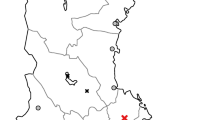Abstract
Objective
This feasibility study aimed to determine the maximum theoretical distance the Edinburgh Paediatric Retrieval Team (EPRT) could travel to retrieve head injured children without additional delay in reaching definitive care.
Design
A prospective audit was conducted over 2 years to determine the current practice for paediatric head injury transfers (stabilisation, referral, and transfer time) undertaken by primary hospital staff, and the performance (mobilisation and travel time) of the EPRT. A novel formula was devised and used to determine the theoretical maximum radius within which the EPRT could reach a referring hospital during their stabilisation of head injured patients.
Measurements and results
During the study period, 27 head injured patients were transferred to our unit by road and the EPRT conducted 194 road retrievals. The median stabilisation time for the head injured patients was 3.6 h. Median time to refer these patients to neurosurgical services was 1 h after presenting to primary hospitals. Median mobilisation time for EPRT was 1 h. Using our novel formula, 67 miles was the theoretical maximum radius within which the EPRT could reach a referring hospital during their stabilisation of head injured patients.
Conclusions
Specialist team retrieval of paediatric head injury is a possibility, but not without significant organisational changes such as availability of second teams, early referral of patients and utilisation of the mobilisation time as a cancellation window. Our novel formula offers other teams a starting point to assess their own performance and to develop services.
Similar content being viewed by others
References
National Collaborating Centre for Acute Care (2007) Head injury: triage, assessment, investigation and early management of head injury in infants, children and adults. In: National Health Service, National Institute for Clinical Excellence, London, pp 71
Scottish Intercollegiate Guidelines Network (2000) Early management of patients with a head injury. In: Scottish Intercollegiate Guideline, Edinburgh, pp 36
Royal College of Paediatrics and Child Health (2001) Clinical appraisal on the SIGN head injury guideline. London
Barry PW, Ralston C (1994) Adverse events occurring during interhospital transfer of the critically ill. Arch Dis Child 71:8–11
Britto J, Nadel S, Maconochie I, Levin M, Habibi P (1995) Morbidity and severity of illness during interhospital transfer: impact of a specialised paediatric retrieval team. BMJ 311:836–839
Cray SH, Heard CM (1995) Transport for paediatric intensive care. Measuring the performance of a specialist transport service. Paediatr Anaesth 5:287–292
Dryden CM, Morton NS (1995) A survey of interhospital transport of the critically ill child in the United Kingdom. Paediatr Anaesth 5:157–160
Edge WE, Kanter RK, Weigle CG, Walsh RF (1994) Reduction of morbidity in interhospital transport by specialized pediatric staff. Crit Care Med 22:1186–1191
Vos GD, Nissen AC, Nieman FH, Meurs MM, van Waardenburg DA, Ramsay G, Donckerwolcke RA (2004) Comparison of interhospital pediatric intensive care transport accompanied by a referring specialist or a specialist retrieval team. Intensive Care Med 30:302–308
Tasker RC, Morris KP, Forsyth RJ, Hawley CA, Parslow RC (2006) Severe head injury in children: emergency access to neurosurgery in the United Kingdom. Emerg Med J 23:519–522
Tasker RC, Gupta S, White DK (2004) Severe head injury in children: geographical range of an emergency neurosurgical practice. Emerg Med J 21:433–437
Author information
Authors and Affiliations
Corresponding author
Rights and permissions
About this article
Cite this article
Dieppe, C., Lo, T.Y.M., McFadzean, J. et al. Specialist team retrieval of head injured patients: fact, fiction, or formula?. Intensive Care Med 35, 334–338 (2009). https://doi.org/10.1007/s00134-008-1323-1
Received:
Accepted:
Published:
Issue Date:
DOI: https://doi.org/10.1007/s00134-008-1323-1




